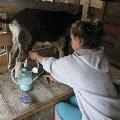This is the VOA Special English Agriculture Report.
Mike Henry has a two-hectare farm in Palmer, Alaska. About a year and a half ago, his goat Millie was giving him a hard time. She did not want to be milked.
She kicked her back legs and stepped into the bucket that was supposed to catch her milk. But there was no milk to catch. All Mike Henry got was tired hands from his attempts to milk her.
But he also got an idea. He designed a goat milking machine that does not require any electricity or motors. The Henry Milker is a hand-operated vacuum pump. A person attaches a tube to the goat and, after a little pumping, the milk begins to flow. A gauge measures the pressure of the suction.
The process uses a closed system to keep hair and dirt out of the milk. The milk goes directly from the goat into a container that is then placed in the refrigerator to keep the milk cold.
Mike Henry has sold his invention to hundreds of people, mainly small farmers who also hold other jobs -- just as he does. Mr. Henry is an executive director in the Anchorage School District in Alaska.
He considered spending more than one thousand dollars for an electric milking machine. But that seemed like a lot of money to milk just one goat. So he began to develop a device of his own. He worked with parts that he bought from an auto supply store and a Wal-Mart store.
He tried the invention on Millie. How did she react? She gave a little milk. As the months passed, he improved the device. Milking Millie became easy. Mike Henry began to think other people who owned just a few goats might be interested in his invention.
So he offered one on eBay, an Internet marketplace. The first one sold for forty-five dollars. Interest grew. Today, he receives orders from as far away as Australia and New Zealand.
The regular price is one hundred forty-nine dollars. Recently he has offered the system for one hundred nineteen dollars, plus shipping and handling charges, at goatfinder.com.
The system is advertised as safe enough for children to use. The ad also says it is not a production milker and not designed to replace commercial machines.
The average milking time with the Henry Milker is ten minutes. Mike Henry says Millie now gives about two liters in half that time.
And that's the VOA Special English Agriculture Report, written by Jerilyn Watson. What is your secret to gaining the cooperation of a goat at milking time? You can comment at voaspecialenglish.com or on Facebook or Twitter at VOA Learning English. I'm Bob Doughty.

